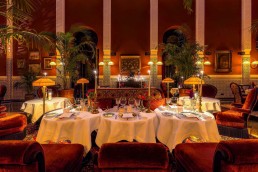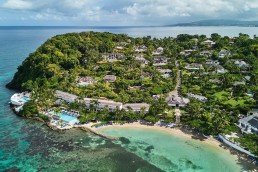Jean-François Piège launches Sabo at Selman Marrakech
Following the September opening of La Terrasse by Jean-François Piège, Selman Marrakech and the multi-Michelin-starred chef continue their collaboration with the launch of Sabo: a restaurant imagined by designer Jacques Garcia.
The menu reflects the hallmarks of French gastronomy, filtered through the lens of Moroccan abundance, and Chef Jean-François Piège drew on his many visits to Marrakech when creating it. Oualidia prawns, prized for their quality, like the oysters from the same region, are flambéed with cognac and served with pepper sauce and fries. Lettuce hearts, typically dressed by Piège with hazelnut oil, are reimagined here with local argan oil. From croque-monsieur topped with caviar to Viennese veal escalope and strawberries soaked in Champagne and finished with rosebuds, the dishes marry French tradition with Moroccan flair.
There’s a light-hearted spirit running through the experience. From the first page, the menu features a ‘Just for Fun’ section, small plates meant for sharing (or not) while waiting for the table to arrive. It’s a clear invitation to place pleasure at the heart of Sabo.
In the kitchen, Piège has installed a wood-fired oven to bring depth and authenticity to the cooking. “It creates a uniquely delicious result, the sea bass cooked this way has an unmistakable flavour,” he says. It’s served with wild fennel and a lemon sabayon made from citrus grown on the estate. With its lush gardens, Selman Marrakech continues to serve as a rich source of inspiration.”
Since opening in 2012, Selman Marrakech, designed by Garcia as an Arab-Moorish palace, has become one of the Red City’s most distinctive addresses. “To us, Garcia is one of the greatest space designers in the world,” says the Bennani Smires Family, owners of the hotel. “He brought our original vision to life perfectly, and even thirteen years later, we’re still amazed by this orientalist universe inspired by the Alhambra that only he could create. So it was only natural to invite him back to design the culinary experience at Sabo.”
Sabo’s setting celebrates the richness of Moroccan craftsmanship: zellige tiles, carved plaster, and handcrafted pieces. Built into a previously unused patio, the space now features a retractable roof that opens to the stars on warm evenings. “In the Medina, many riads are built around central courtyards that allow for magical open-air dinners. We wanted to recreate that same enchantment. This restaurant is designed to showcase the best of French gastronomy for a Moroccan audience, and the finest of Moroccan hospitality for French and international guests.”
Sabo also extends into the hotel’s bar library, offering a more private space for drinks or dinner. Though part of Selman Marrakech, it stands as a restaurant in its own right, with a dedicated kitchen, private entrance, and its own website.
“I want SABO to be, above all, a restaurant that delights its guests while staying true to the spirit of Selman Marrakech, a place that, to me, has a real soul,” concludes Piège.
Related Posts
5 December 2025
Round Hill Hotel and Villas hosts Rocco DiSpirito
2 December 2025




